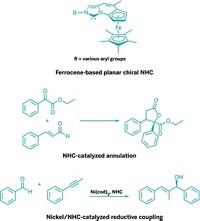Advertisement
Grab your lab coat. Let's get started
Welcome!
Welcome!
Create an account below to get 6 C&EN articles per month, receive newsletters and more - all free.
It seems this is your first time logging in online. Please enter the following information to continue.
As an ACS member you automatically get access to this site. All we need is few more details to create your reading experience.
Not you? Sign in with a different account.
Not you? Sign in with a different account.
ERROR 1
ERROR 1
ERROR 2
ERROR 2
ERROR 2
ERROR 2
ERROR 2
Password and Confirm password must match.
If you have an ACS member number, please enter it here so we can link this account to your membership. (optional)
ERROR 2
ACS values your privacy. By submitting your information, you are gaining access to C&EN and subscribing to our weekly newsletter. We use the information you provide to make your reading experience better, and we will never sell your data to third party members.
Synthesis
Carbenes Take On A New Dimension
Asymmetric Synthesis: Pairing ferrocene with an imidazolium ring system results in planar chiral catalysts
by Stephen K. Ritter
January 29, 2015
| A version of this story appeared in
Volume 93, Issue 5
Imidazolium-based N-heterocyclic carbenes (NHCs) are versatile molecules, used as ligands in transition-metal catalysts and as metal-free organocatalysts. However, only a few successful chiral versions have been reported.
A research team led by Christopher T. Check and Karl A. Scheidt of Northwestern University set out to change that situation by fusing a metal sandwich complex with an NHC framework. In doing so, they created a new class of NHCs with a rigid planar chiral imidazolium ring system that can be tuned to serve as a ligand or organocatalyst by altering the substituents on the imidazolium ring (Angew. Chem. Int. Ed. 2015, DOI: 10.1002/anie.201410118).
The Northwestern chemists first synthesized a ferrocene derivative with a cyclopentadienyl ligand on one side of the sandwich and a cyclopentapyridinyl ligand bearing a pseudoephedrine side chain on the other. After separating the resulting enantiomers, they carried out an additional reaction sequence to finalize formation of the imidazolium ring system.
“This new molecule represents a creative translation of the notion of planar chirality to the bond-forming business end of the NHC ligand-catalyst scaffold,” says Scott J. Miller of Yale University, whose group develops catalytic methods. “In doing so, the researchers have provided new dials to turn for optimizing catalysts. It is very thought-provoking and stimulating work.”
With the ferrocene-based chiral NHC in hand, Scheidt and coworkers carried out a series of reactions. In one example, the team used the new NHC as an enantioselective organocatalyst for aryl homoenolate additions to aryl α-ketoesters. In another example, they paired the NHC with nickel for reductive coupling of phenylpropyne with aldehydes to form allylic alcohols in high regioselectivity and enantiomeric excess.
“These NHCs are a result of really smart modular design,” comments NHC specialist Frank Glorius of the University of Münster, in Germany. “The researchers convincingly show that these NHCs are incredibly versatile, being applicable as chiral organocatalysts in their own right and as ligands in nickel- and copper-catalyzed asymmetric transformations. It would be great if this family of NHCs could quickly become commercially available.”






Join the conversation
Contact the reporter
Submit a Letter to the Editor for publication
Engage with us on Twitter